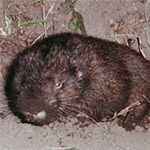
Fellers, USGS Mountain Beaver The mountain beaver (Aplodontia rufa) is a unique rodent found only in the western portions of southern British Columbia, Washington, Oregon, and northern California. The mountain beaver is not a "true" beaver, but was so named by California miners due to its habitat of cutting limbs and gnawing bark, similar to that of the beaver. The mountain beaver, which also is known as "boomer" and "sewellel", is actually a very primitive mammal belonging to the oldest known family of living rodents. It is the sole living member of the family Aplodontidae. Mountain beavers are approximately 12 inches (30 centimeters) long and weigh about 2 pounds (900 grams). They are brown or black, have very short stubby tails, and are stocky in appearance. Although primarily nocturnal they will venture out during daylight hours and have been seen in various locations in Redwood National and State Parks. Mountain beavers are solitary, and defend small, up to 0.5 acre (0.2 hectare), territories. The most remarkable things about the mountain beaver are the elaborate system of burrows it builds and its habitat of making "hay". Burrows Hay-making Places in Redwood National and State Parks where mountain beavers have been observed include trails near the Smith River in Jedediah Smith Redwoods State Park, Damnation Creek, the Klamath River overlook, Flint Ridge Trail near Marshall Pond, and the Coastal Trail near the DeMartin back country campground. |
Last updated: February 28, 2015
